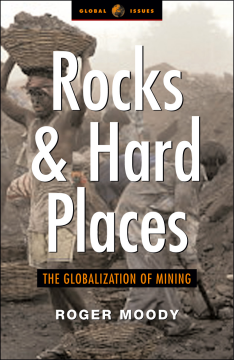
Additional Information
Book Details
Abstract
The world of international mining is changing rapidly. Mining corporations are encroaching on more and more greenfield sites in Africa, the Asia-Pacific and Latin America, to serve ever-expanding global industries.
Moody shows that large-scale mining imposes a heavy toll on local communities, on their fragile economies and ways of life, as well as the environment. He challenges the mining corporations' recent public relations offensive extolling the virtues of largescale mining and its alleged compatibility with sustainable development, and reveals the unprecedented wave of community and trade union opposition to projects in both the South and the North.
This important book concludes with urgent proposals to check the role of multinationals in a sector that has always been at the core of resource exploitation.
Roger Moody is an experienced international researcher and campaigner who has traveled extensively, particularly in the Asia-Pacific region. As an activist he has worked with community organizations in South America, the Asia-Pacific and Africa. Among his many works are the highly acclaimed The Gulliver File: Mines, People and Land - A Global Battleground (1992), The Indigenous Voice: Visions and Realities (Zed 1988) and his most recent work, The Risks We Run: Mining, Communities and Political Risk Insurance (2005).
'Rocks and Hard Places brings to the surface the disparities of economy, and the resilience and tenacity of indigenous communities, in the face of generation after generation of exploitation. It makes us deeply aware of the cycles of colonialism which continue to lie at the heart of the global mining industry.'
Winona LaDuke, Indigenous Womens Network
Table of Contents
| Section Title | Page | Action | Price |
|---|---|---|---|
| Cover\r | Cover | ||
| Contents | vii | ||
| List of boxes | ix | ||
| Acknowledgements | x | ||
| 1 | Through the minefield | 1 | ||
| Defining sustainability | 5 | ||
| What to mine? | 7 | ||
| The how of it | 9 | ||
| When to mine? | 9 | ||
| Where not to go? | 10 | ||
| Who should do the mining? | 11 | ||
| Notes | 14 | ||
| 2 | How the World Bank backs bad miners | 16 | ||
| Code-breaking | 19 | ||
| Broken promises | 23 | ||
| Sustained non-development | 27 | ||
| Bad marks all round | 28 | ||
| Wolfowitz in sheep’s clothing | 35 | ||
| Notes | 40 | ||
| 3 | Cursed by resources | 43 | ||
| Botswana: are diamonds the best of friends? | 48 | ||
| Chile: relying on a copper-bottomed future | 49 | ||
| The nationalization option | 52 | ||
| A taxing question | 54 | ||
| Entertaining royalties | 56 | ||
| Empowering South Africans? | 56 | ||
| What is the true wealth of nations? | 63 | ||
| Notes | 65 | ||
| 4 | Blood, toil and tears | 69 | ||
| The toll of coal | 73 | ||
| Dying for a living | 76 | ||
| Working women | 80 | ||
| Catching them young | 85 | ||
| Small in scale, but big in problems | 88 | ||
| Forging ‘Just Transition’ | 92 | ||
| Notes | 95 | ||
| 5 | The destruction of construction | 99 | ||
| ‘Broken – just like the stone we break’ | 101 | ||
| Bricks in the wall | 109 | ||
| Shifting sands | 111 | ||
| Cement: the burning question | 114 | ||
| Can we green houses? | 121 | ||
| Notes | 124 | ||
| 6 | Sacrifice areas | 127 | ||
| Lethal legacies | 129 | ||
| The world’s worst places 2006 | 135 | ||
| Poisoned chalices | 143 | ||
| Fourteen years of failure, 1992–2006 | 145 | ||
| Notes | 151 | ||
| 7 | Winning hearts and mines | 154 | ||
| Globalizing the propaganda | 156 | ||
| Mining, minerals and sustainable development | 158 | ||
| Taking one’s partners | 161 | ||
| When decisions are at stake | 170 | ||
| Defining ‘community’ | 172 | ||
| Notes | 175 | ||
| 8 | No means no! | 179 | ||
| Round the tables | 180 | ||
| A dead cert? | 183 | ||
| Growing from the roots | 190 | ||
| Notes | 194 | ||
| Appendix: the London Declaration | 197 | ||
| Index | 202 |
